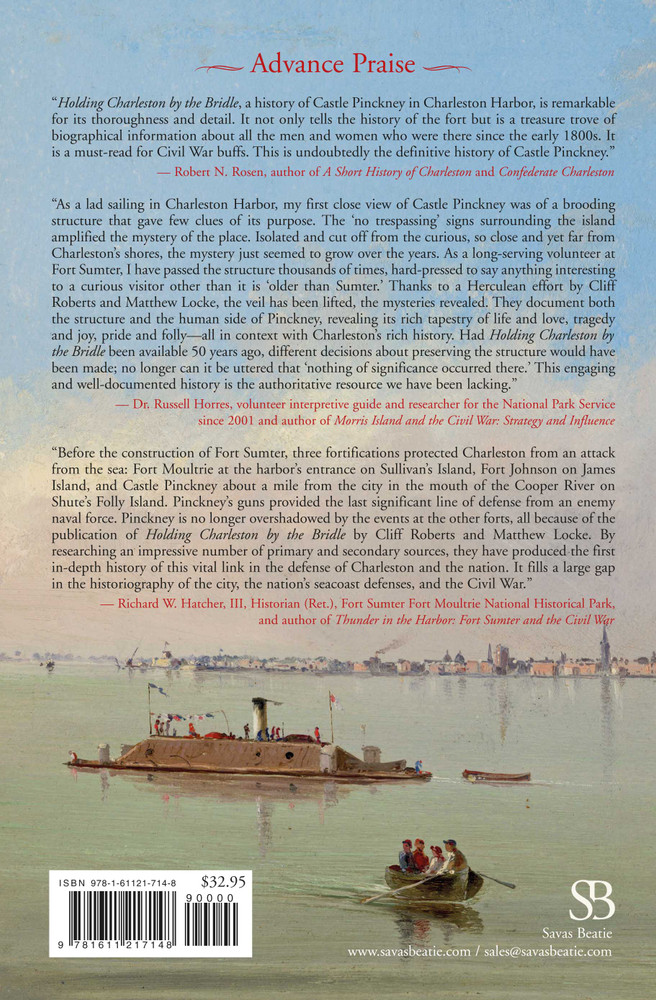Holding Charleston by the Bridle: Castle Pinckney and the Civil War
- Current Stock:
- Gift wrapping:
- Options available
- Authors:
- W. Clifford Roberts and Matthew A. M. Locke
- Pub Date:
- July 2024
- ISBN:
- 978-1-61121-714-8
- eISBN:
- 978-1-954547-65-0
- Binding:
- Hardcover
- Specs:
- photos, maps, 288 pp.
eBook coming soon
Excerpt coming soon
About the book
On the eve of the Civil War, the London Times informed its readers that Castle Pinckney has “been kept garrisoned, not to protect Charleston from naval attack from the ocean, but to serve as a bridle upon the city.” Located on a marshy island in the center of Charleston’s magnificent harbor, the large cannons on the ramparts of this horseshoe-shaped masonry fort had the ability to command downtown Charleston and the busy wharves along East Bay Street. This inescapable fact made Pinckney an important chess piece in the secession turmoil of 1832 and 1850, and in the months leading up to the 1861 bombardment of Fort Sumter.
Holding Charleston by the Bridle: Castle Pinckney and the Civil War by Cliff Roberts and Matthew Locke is the first book on the subject, from the fort’s innovative design as part of America’s “Second System” of coastal fortifications to the modern challenges of preserving its weathered brick walls against rising sea levels. The impressive bastion was constructed as a state-of-the-art seacoast fortress on the eve of the War of 1812. President James Monroe and Gens. Winfield Scott, Robert E. Lee, and P. G. T. Beauregard inspected its casemates and barracks. The history of Pinckney is as impressive as its list of visiting VIPs.
Defending the fort was one of Winfield Scott’s major concerns during the Nullification Crisis of 1832. Seminole Indians and Africans from the illegal slave ship Echo were held there. In 1860, Maj. Robert Anderson knew the fort was the key to protecting his small Federal garrison at Fort Moultrie, but his requests to Washington for troops to hold the Castle went unheeded. That December, three companies of Charleston militia scaled and seized the fort in a daring act that pushed the nation to the edge of civil war. After First Manassas (Bull Run), 156 captured Yankee officers and enlisted men were sent to the island, and in 1863, members of the famed 54th Massachusetts were held there as POWs. The fort’s guns helped defend the city during the war’s longest siege. By 1865, the old fortress had been transformed into an earthen barbette battery with a Brooke Rifle and three giant 10-inch Columbiads. During Reconstruction, the Castle became an “American Bastille” for Southerners accused of crimes against the government.
Roberts and Locke rely on extensive primary research and archaeological evidence to tell the full story of Castle Pinckney for the first time. Given its importance to America’s history, it is a history long overdue.
Advance Praise
“Holding Charleston by the Bridle, a history of Castle Pinckney in Charleston Harbor, is remarkable for its thoroughness and detail. It not only tells the history of the fort, but is a treasure trove of biographical information about all the men and women who were there since the early 1800s. It is a must-read for Civil War buffs. This is undoubtedly the definitive history of Castle Pinckney.”
— Robert N. Rosen, author of A Short History of Charleston and Confederate Charleston
“As a lad sailing in Charleston Harbor, my first close view of Castle Pinckney was of a brooding structure that gave few clues of its purpose. The “no trespassing” signs surrounding the island amplified the mystery of the place. Isolated and cut off from the curious, so close and yet far from Charleston’s shores, the mystery just seemed to grow over the years. As a long-serving volunteer at Fort Sumter, I have passed the structure thousands of times, hard-pressed to say anything interesting to a curious visitor other than it is “older than Sumter.” Thanks to a Herculean effort by Cliff Roberts & Matthew Locke, the veil has been lifted, the mysteries revealed. They document both the structure and the human side of Pinckney, revealing it rich tapestry of life and love, tragedy and joy, pride and folly—all in context with Charleston’s rich history. Had Holding Charleston by The Bridle been available fifty years ago, much different decisions about preserving the structure would have been made; no longer can it be uttered that “nothing of significance occurred there.” This engaging and well-documented history is the authoritative resource we have been lacking.”
— Dr. Russell Horres, volunteer interpretive guide and researcher for National Park Service since 2001 and author of Morris Island and the Civil War: Strategy and Influence
“Before the construction of Fort Sumter, three fortifications protected Charleston from an attack from the sea: Fort Moultrie at the harbor’s entrance on Sullivan’s Island, Fort Johnson on James Island, and Castle Pinckney about a mile from the city in the mouth of the Cooper River on Shute’s Folly Island. Pinckney’s guns provided the last significant line of defense from an enemy naval force. Pinckney is no longer overshadowed by the events at the other forts, all because of the publication of Holding Charleston by the Bridle by Cliff Roberts and Matthew Locke. By researching an impressive number of primary and secondary sources, they have produced the first in-depth history of this vital link in the defense of Charleston and the nation. It fills a large gap in the historiography of the city, the nation’s seacoast defenses, and the Civil War.”
— Richard W. Hatcher, III, Historian Ret., Fort Sumter Fort Moultrie National Historical Park, and author of Thunder in the Harbor: Fort Sumter and the Civil War
About the Authors: W. Clifford Roberts is a retired businessman and educator and the co-author of Atlanta’s Fighting 42nd: Joseph Johnston’s “Old Guard” (2020). Cliff was raised outside of Washington, D.C. and has a BA in Southern history from Vanderbilt University (1981) and an MBA from Emory University (1983). An active board member of several historical, preservation, and genealogical associations, Cliff lives with his wife Vicki and dog Hashbrown in downtown Charleston. Matthew Locke was born and educated in London where he worked as an Executive Officer in the British Civil Service. As a passionate student of the Civil War and living historian, he visited Charleston in 1999, fell in love with the city, and became fascinated with Castle Pinckney. He moved to South Carolina in 2001 and began researching the history of the Castle and Shutes Folley Island. In 2021, he was appointed as a Guardian of Castle Pinckney and works there with archeologists, historians, and conservationists. Matthew, his wife Jacqueline, and daughter Abigail live just outside Charleston.





